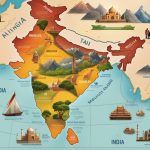Did you know that India is home to the world’s second-largest population, with over 1.3 billion people? This staggering statistic highlights the immense potential and scale of the Indian market, making it a compelling destination for businesses looking to expand globally.
In this article, we will explore the fascinating intersection of business statistics and culture in India. We’ll delve into the key insights that will help entrepreneurs navigate India’s dynamic commercial landscape and understand the nuances of conducting business in one of the fastest-growing economies in the world.
Key Takeaways:
- India has the world’s second-largest population, with over 1.3 billion people, making it a vast market for businesses.
- Understanding the business culture in India is crucial for establishing successful operations and building strong relationships.
- Key industries in India include information technology, manufacturing, and services, all contributing significantly to the country’s economic growth.
- The Indian market presents both challenges and opportunities, requiring entrepreneurs to adapt their strategies to navigate cultural and competitive landscapes.
- By embracing cultural sensitivity and adaptation, businesses can forge meaningful connections with Indian consumers and gain a competitive edge in the market.
Understanding India’s Business Landscape
India’s Business Landscape offers a unique set of opportunities and challenges for entrepreneurs and businesses alike. To navigate this dynamic environment, it is essential to understand the factors that shape India’s commercial landscape.
Size of the Market
With a population of over 1.3 billion people, India boasts one of the largest consumer markets in the world. This vast market presents immense potential for businesses across various industries, including retail, manufacturing, and services.
Multinational Corporations
India has become a magnet for multinational corporations seeking to expand their global footprint. Companies like Amazon, Google, and Microsoft have established a significant presence in the country, tapping into the growing consumer base and leveraging India’s skilled workforce.
Economic Climate
India’s economic climate plays a vital role in shaping its business landscape. The country has been experiencing steady economic growth over the past decade, with sectors such as information technology, telecommunications, and e-commerce driving its expansion.
Moreover, ongoing government initiatives, such as “Make in India” and “Digital India,” aim to boost domestic manufacturing and digital transformation, attracting more investments and enhancing the overall business ecosystem.
Summary
In summary, understanding India’s business landscape is crucial for entrepreneurs looking to capitalize on the country’s vast market potential. Factors such as the size of the market, the presence of multinational corporations, and the overall economic climate all influence the business environment in India.
In the next section, we will delve into key business statistics in India, shedding light on crucial economic indicators that can help entrepreneurs make informed business decisions.
Key Business Statistics in India
When it comes to understanding the Indian economy, key business statistics play a crucial role. These statistics provide entrepreneurs with valuable insights into the country’s economic performance and help shape business strategies. In this section, we’ll explore some of the most important business statistics in India, including the GDP growth rate, inflation, and the unemployment rate.
Gross Domestic Product (GDP) Growth Rate
The GDP growth rate is a significant indicator of a country’s economic health. It measures the rate at which the country’s economy is expanding or contracting over a specific period. In India, the GDP growth rate has been impressive in recent years, with an average growth rate of around 7% to 8%. This demonstrates the country’s resilience and potential for business growth.
Inflation Rate
Inflation refers to the general rise in prices of goods and services over time. It is an essential aspect to consider for businesses as it impacts purchasing power and consumer behavior. In India, the inflation rate has seen fluctuations but has been relatively stable, hovering around 4% to 6% in recent years. This stability provides a favorable environment for businesses to plan and forecast their operations.
Unemployment Rate
The unemployment rate is a critical indicator of job opportunities and labor market conditions. The lower the unemployment rate, the better the chances for businesses to find and retain skilled employees. In India, the unemployment rate has been a challenge, with figures ranging from 5% to 7%. However, the government has implemented various initiatives to boost employment, creating opportunities for both domestic and foreign businesses.
Understanding these key business statistics and their implications is essential for entrepreneurs looking to establish and grow their businesses in India. These statistics provide a glimpse into the country’s economic performance and help entrepreneurs make informed decisions. By keeping a close eye on these metrics, businesses can identify trends, adapt strategies, and position themselves for success in the dynamic Indian market.
Industries Driving India’s Economy
India’s economy is powered by various industries that contribute significantly to its growth and development. In this section, we will explore three key sectors that play a crucial role in driving India’s economy: information technology, manufacturing, and services.
1. Information Technology
The information technology (IT) sector in India has witnessed remarkable growth over the years. With a skilled workforce, competitive cost advantage, and a supportive regulatory environment, India has become a global hub for IT services. Leading Indian IT companies such as Tata Consultancy Services (TCS), Infosys, and Wipro have established a strong presence both domestically and internationally, offering a wide range of services including software development, consulting, and IT-enabled services.
This sector has been instrumental in driving India’s digital transformation and has played a significant role in sectors such as healthcare, finance, retail, and e-commerce. With the increasing adoption of technologies like artificial intelligence, cloud computing, and data analytics, the IT industry is expected to continue its growth trajectory, contributing to India’s economic development.
2. Manufacturing
The manufacturing sector in India has emerged as a major driver of the country’s economic growth. India is one of the largest manufacturers of textiles, automobiles, pharmaceuticals, and consumer goods in the world. The ‘Make in India’ initiative launched by the government has further enhanced the country’s manufacturing capabilities and attracted foreign investments.
India’s skilled labor force, vast consumer market, and favorable demographic dividend have made it an attractive destination for manufacturing companies. The sector’s growth has been fueled by advancements in technology, automation, and government initiatives like Goods and Services Tax (GST) and ease of doing business reforms. With a focus on sustainable and inclusive growth, the manufacturing sector is poised to contribute significantly to India’s economic progress in the coming years.
3. Services
The services sector is another key contributor to India’s economy. It encompasses a wide range of industries such as banking, financial services, insurance, tourism, hospitality, and outsourcing. India’s expansive services sector has been fueled by factors like a young and skilled workforce, English proficiency, and a competitive cost advantage.
The country’s strong business process outsourcing (BPO) industry has been a major driver of the services sector, providing services like customer support, technical assistance, and back-office operations to global clients. Additionally, India has emerged as a popular destination for medical tourism, with top-notch healthcare facilities and affordable treatment options attracting patients from around the world.
The services sector’s growth and potential for innovation are expected to play a vital role in India’s journey towards becoming a global economic powerhouse.
| Sector | Contribution | Growth Potential |
|---|---|---|
| Information Technology | Significant contribution to GDP | Continued growth with increased adoption of emerging technologies |
| Manufacturing | Employment generation and export revenue | Potential for expansion in high-value manufacturing sectors |
| Services | Largest contributor to GDP | Growth in areas like healthcare, tourism, and financial services |
Government Initiatives and Policies
In India, government initiatives and policies play a crucial role in shaping the business environment and fostering economic growth. Entrepreneurs and businesses operating in the country need to stay updated on these initiatives and policies to effectively navigate the Indian market.
One significant government initiative is the “Make in India” campaign, which aims to promote domestic manufacturing and attract foreign investment. This initiative has led to the implementation of various policies and reforms to simplify the process of starting and operating businesses in India. The government has made efforts to improve the ease of doing business by streamlining bureaucratic procedures, reducing red tape, and enhancing the overall business ecosystem.
Foreign investment regulations have also been a key focus of the Indian government. The introduction of initiatives such as the Foreign Direct Investment (FDI) policy allows foreign investors to participate in several sectors and has opened up opportunities for global partnerships and collaborations. These policies have helped attract foreign capital and technology, contributing to the growth of various industries in the country.
Tax reforms have been another area of focus for the Indian government. The Goods and Services Tax (GST) implementation, which replaced multiple indirect taxes, has simplified the tax structure and increased transparency. This reform has had a significant impact on businesses by reducing tax complexities and promoting a unified market across the country.
Additionally, the Indian government has implemented various sector-specific policies and initiatives to support specific industries such as information technology, renewable energy, and healthcare. These policies often include incentives, subsidies, and regulatory support to encourage investment and growth in targeted sectors.
The government’s initiatives and policies in India demonstrate its commitment to creating a favorable business environment and attracting investments. By staying informed about these initiatives and policies, businesses can position themselves strategically and take advantage of the opportunities available in the Indian market.
The Impact of Government Initiatives and Policies
The government initiatives and policies in India have had a significant impact on the business landscape, fostering economic growth and attracting global investments. Some key impacts include:
- Increased ease of doing business: The government’s focus on simplifying procedures and reducing bureaucratic hurdles has made it easier for entrepreneurs to start and operate businesses in India.
- Foreign investment inflow: Initiatives such as the “Make in India” campaign and FDI policies have attracted foreign investments, leading to the growth of various industries and creating employment opportunities.
- Market expansion: Sector-specific policies and initiatives have supported the growth of industries like information technology, renewable energy, and healthcare, expanding their reach and contributing to overall economic development.
- Enhanced tax compliance: The implementation of the GST has streamlined the tax structure and increased tax compliance, creating a transparent and uniform tax system across the country.
The government initiatives and policies in India continue to evolve as the country strives to create a conducive environment for businesses. Staying updated on these initiatives is crucial for entrepreneurs looking to navigate the Indian market and leverage the opportunities available.
Business Culture and Etiquette in India
When conducting business in India, it is essential to understand and respect the unique business culture and etiquette prevalent in the country. India’s rich history and diverse cultural practices greatly influence the way business is conducted, emphasizing the importance of building strong relationships and displaying proper decorum.
Hierarchy in the Workplace
In Indian business culture, hierarchy plays a crucial role. The workplace often follows a hierarchical structure, with clear lines of authority and respect for seniority. Decision-making is typically top-down, and it is important to address superiors with respect and deference. Understanding the hierarchy and demonstrating proper deference is key to building successful professional relationships.
Communication Styles
Communication in India is often indirect and relies heavily on non-verbal cues. It is important to pay attention to gestures, facial expressions, and body language during conversations, as these can convey nuances and additional meaning. Indians value politeness and may be more inclined to use phrases like “maybe,” “we’ll see,” or “let me think about it” to express hesitation or disagreement. Patience and attentive listening are crucial for effective communication.
Business Negotiation Practices
When negotiating business deals in India, it is important to proceed with patience and tact. Indians value building relationships and trust before finalizing agreements. Negotiations can be lengthy as both parties strive for a win-win outcome. It is advisable to engage in small talk and establish personal rapport before delving into business matters. Indirect communication techniques, such as storytelling or using anecdotes to illustrate points, can be effective in negotiations.
Managing Time
In Indian business culture, time is perceived differently compared to Western cultures. Punctuality is appreciated, but meetings and events may start later than scheduled. Flexibility and understanding are essential when it comes to time management. It is advisable to have a flexible schedule and be prepared for unexpected changes or delays.
Understanding and respecting Indian business culture and etiquette is crucial for building successful business relationships in the country. By being mindful of hierarchy, adapting communication styles, practicing patience in negotiations, and being flexible with time management, entrepreneurs can navigate the Indian business landscape more effectively.
Understanding Indian Consumer Behavior
In today’s competitive business landscape, understanding consumer behavior is essential for success. This holds true for businesses operating in India as well. Indian consumer behavior is shaped by various factors, including demographics, purchasing power, and consumer preferences.
Influence of Demographics
India’s diverse population, with over 1.3 billion people, presents businesses with a range of consumer segments. Demographic factors such as age, gender, income levels, and geographical location play a significant role in shaping consumer preferences. Understanding these demographics can help businesses tailor their products and marketing strategies to specific target audiences.
Purchasing Power and Spending Patterns
The purchasing power of Indian consumers has been steadily increasing. As the middle class expands and disposable incomes rise, consumers are becoming more willing to spend on discretionary items. However, price sensitivity still affects purchasing decisions for many consumers. It is important for businesses to strike the right balance between quality and affordability when catering to Indian consumers.
Preference for Local and Trusted Brands
Indian consumers tend to have a preference for local and trusted brands. This preference is driven by factors such as familiarity, perceived quality, and value for money. Many Indian consumers prioritize buying products and services from brands they trust and have a long-standing relationship with. Therefore, building trust and establishing a strong brand presence are key considerations for businesses entering the Indian market.
The Impact of E-commerce
E-commerce has witnessed significant growth in India, spurred by increasing internet penetration and smartphone usage. Indian consumers are increasingly turning to online platforms for convenience, choice, and competitive pricing. This trend has opened up new opportunities for businesses to reach and engage with consumers across the country, regardless of geographical barriers.
Consumer Behavior During Festivals and Celebrations
Festivals and celebrations hold immense cultural significance in India. During these occasions, consumers tend to increase their spending on various products and services. Businesses can leverage this cultural behavior by offering festival-specific promotions, discounts, and customized product offerings. The ability to understand and tap into these festive buying patterns can contribute to business growth.
| Key Factors Shaping Indian Consumer Behavior: |
|---|
| Demographics |
| Purchasing Power and Spending Patterns |
| Preference for Local and Trusted Brands |
| The Impact of E-commerce |
| Consumer Behavior During Festivals and Celebrations |
Challenges and Opportunities in the Indian Market
When venturing into the Indian market, entrepreneurs need to be aware of both the challenges and the vast opportunities that lie ahead. Understanding and navigating these factors will play a crucial role in determining success. In this section, we will explore the key challenges and opportunities that businesses may encounter in their journey in the Indian market.
Competition:
One of the significant challenges in the Indian market is fierce competition. With a population of over 1.3 billion and a growing consumer base, various local and international businesses are vying for market share. Entrepreneurs need to develop innovative strategies to differentiate their offerings and stand out in a highly competitive landscape.
Cultural Barriers:
India’s rich cultural heritage and diverse population present both opportunities and challenges for businesses. Cultural nuances, language diversity, and regional preferences can impact communication, marketing strategies, and customer engagement. Entrepreneurs must invest time and effort in understanding the cultural context to effectively connect and engage with Indian consumers.
Emerging Market Trends:
The Indian market is constantly evolving, driven by technological advancements and changing consumer behavior. Entrepreneurs who can identify and capitalize on emerging market trends have a higher chance of success. Keeping a close eye on factors such as e-commerce growth, digital adoption, and shifting consumer preferences will enable businesses to stay ahead of the curve and leverage new opportunities.
By addressing these challenges head-on and capitalizing on the numerous opportunities, entrepreneurs can establish a strong foothold in the Indian market. The next section will provide practical strategies for success, allowing businesses to navigate through the complexities and thrive in this dynamic business landscape.
| Challenges | Opportunities |
|---|---|
| Intense competition | Rapidly growing consumer base |
| Cultural barriers and diversity | Untapped market segments |
| Changing consumer behavior | Emerging sectors and industries |
| Complex regulatory environment | Government initiatives and support |
Strategies for Success in India
When entering the Indian market, entrepreneurs must employ effective strategies to achieve success. By understanding the unique business landscape, conducting thorough market research, and adapting to the local culture, businesses can position themselves for growth and profitability.
1. Market Research
Market research is a crucial step in developing a successful business strategy for India. It provides valuable insights into consumer preferences, market trends, and competitors. Conducting comprehensive research helps identify opportunities, assess demand, and tailor products or services to meet the specific needs of the Indian market.
Key factors to consider during market research include customer behaviour, purchasing power, cultural nuances, and regional variations. By understanding the intricacies of the Indian market, entrepreneurs can make informed decisions and develop effective marketing and sales strategies.
2. Localization
Localization is essential for businesses seeking success in India. Adapting products, services, and marketing strategies to cater to the local audience demonstrates cultural sensitivity and improves customer engagement. This includes translating content into local languages, incorporating Indian aesthetics and traditions, and customizing products to suit the preferences of Indian consumers.
Furthermore, forming partnerships with local distributors or hiring native employees can provide valuable insights and connections within the Indian market. Building strong relationships with local stakeholders helps to establish trust, navigate bureaucracy, and overcome potential challenges.
3. Building Strong Partnerships
Collaborating with local partners and building strong relationships is key to success in India. These partnerships can provide access to local networks, distribution channels, and industry expertise. Joint ventures, strategic alliances, or partnerships with Indian companies can help mitigate risks and overcome barriers to market entry.
Entrepreneurs should prioritize building long-term, mutually beneficial partnerships based on trust and shared values. These partnerships can provide valuable support in navigating the complex regulatory environment, understanding local business practices, and developing networks within the Indian business community.
| Benefits of Strategies for Success in India | Challenges of Strategies for Success in India |
|---|---|
|
|
Cultural Sensitivity and Adaptation
Understanding cultural sensitivity and adaptation is crucial for businesses operating in India. When conducting business in a foreign country, it is essential to respect and appreciate the local customs, traditions, and values in order to foster positive relationships and avoid misunderstandings.
The Importance of Cultural Sensitivity
Indian culture is diverse, rich, and deeply rooted. It is important for businesses to recognize and appreciate this diversity. By showing cultural sensitivity, businesses can build trust, establish long-term partnerships, and create a positive brand image among the local population.
Cultural sensitivity involves having an open mind, being receptive to different perspectives, and demonstrating empathy towards cultural differences. By embracing cultural sensitivity, businesses can avoid unintentionally causing offense or engaging in inappropriate behavior that may hinder their success.
Adapting to Local Customs and Traditions
Adapting to local customs and traditions is key to establishing a strong presence in the Indian market. This includes understanding social norms, greetings, and appropriate behavior in different settings. For example, addressing someone by their proper title and using respectful language is highly valued in Indian business culture.
Another important aspect of cultural adaptation is the concept of hierarchy. In India, hierarchies are often respected and influential in various business settings. Understanding and adhering to these hierarchies can play a significant role in establishing successful business relationships.
Building Trust through Cultural Adaptation
Building trust is essential in any business environment, and cultural adaptation plays a vital role in this process. By demonstrating an understanding of and respect for the local culture, businesses can establish trust among their Indian counterparts, employees, and customers.
Additionally, businesses should consider the importance of time and patience when conducting business in India. Cultivating strong relationships takes time, and rushing the process may harm the chances of long-term success.
Case Study: Coca-Cola’s Cultural Adaptation in India
Coca-Cola is a global brand that has successfully adapted its marketing strategy to resonate with the cultural values of India. One of their notable initiatives was the “Thanda Matlab Coca-Cola” campaign, which translated to “Cold Means Coca-Cola.” This campaign connected the brand with the colloquial language and cultural significance of “thanda,” meaning refreshment in India.
Through this campaign, Coca-Cola showcased its commitment to cultural sensitivity and adaptation by understanding and incorporating local traditions and preferences into its marketing efforts. This approach enabled the brand to establish a strong presence in the Indian market and connect with consumers on a deep cultural level.
Future Trends and Growth Potential
In this final section, we turn our attention to the future trends and growth potential in the Indian market. As India continues to experience rapid economic growth, several emerging sectors are poised to shape the business landscape.
One of the key areas to watch is the technology sector. India has emerged as a global IT hub, with a strong focus on software development, cybersecurity, and artificial intelligence. As the country pushes for digital transformation, businesses that embrace these technological advancements can tap into a vast market with immense potential for growth.
Another exciting trend is the shifting consumer behavior. As the middle class continues to expand and disposable incomes rise, there is a growing demand for high-quality products and personalized services. Businesses that can cater to this evolving consumer landscape and deliver exceptional customer experiences will have a significant advantage in the Indian market.
Additionally, the government’s commitment to renewable energy and sustainability presents a promising opportunity. The focus on clean energy and environmentally friendly practices creates a favorable environment for businesses operating in sectors such as solar power, electric vehicles, and waste management.
FAQ
Q: What are the key business statistics in India?
A: The key business statistics in India include the GDP growth rate, inflation rate, and unemployment rate. These statistics provide valuable insights into the Indian economy and its performance.
Q: Which industries drive India’s economy?
A: The industries that drive India’s economy include information technology, manufacturing, services, agriculture, and healthcare. These sectors contribute significantly to the country’s GDP and job creation.
Q: What government initiatives and policies impact the business environment in India?
A: The government of India has implemented various initiatives and policies that impact the business environment. These include measures to improve the ease of doing business, promote foreign investment, and introduce tax reforms.
Q: What is the business culture and etiquette in India like?
A: The business culture in India is diverse and hierarchical, with respect for authority and seniority being important. Communication styles can be indirect, and business negotiations often involve building personal relationships and trust.
Q: What factors influence Indian consumer behavior?
A: Indian consumer behavior is influenced by factors such as demographics, purchasing power, cultural preferences, and value for money. Understanding these factors is crucial for businesses targeting the Indian market.
Q: What challenges and opportunities exist in the Indian market?
A: The Indian market presents both challenges and opportunities for businesses. Challenges include intense competition, cultural barriers, and complex regulatory processes. However, there are also opportunities for growth due to a large consumer base and emerging market trends.
Q: What are some strategies for success in the Indian market?
A: To succeed in the Indian market, businesses should conduct thorough market research, customize products or services to local preferences, establish strong partnerships, and adapt to the Indian business culture and practices.
Q: Why is cultural sensitivity and adaptation important in India?
A: Cultural sensitivity and adaptation are crucial in India because it helps businesses build positive relationships with local partners and customers. Respecting local customs, traditions, and values is key to establishing trust and credibility.
Q: What are the future trends and growth potential in the Indian market?
A: The Indian market offers growth potential in sectors such as e-commerce, renewable energy, healthcare, and digital technology. Shifts in consumer behavior and technological advancements are expected to drive future trends in the Indian market.

















